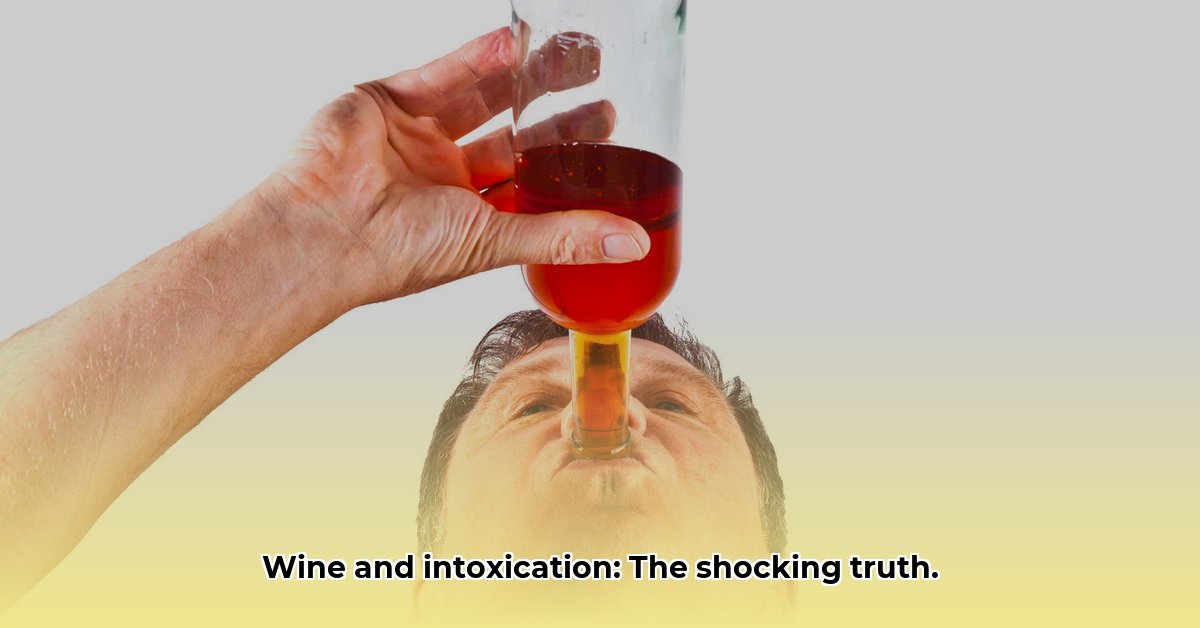Decoding the Wine Buzz: How Wine Affects You
Yes, wine can definitely get you drunk. Like beer, liquor, and cocktails, wine contains ethanol—the alcohol responsible for intoxication. Wine typically has an alcohol by volume (ABV) between 5% and 15%, a measure of how much ethanol is in each sip. Higher ABV means a quicker and more intense effect. Some wines exceed 15% ABV, so checking the label is always wise.
Why Does Wine’s Impact Vary?
Several factors influence how wine affects you. The most obvious is the ABV. A wine with a higher ABV will likely intoxicate you faster than one with a lower ABV. However, individual factors play a crucial role. Your body processes alcohol at its own pace, influenced by factors like size, sex, and genetics. Women often feel alcohol’s effects faster than men because their bodies process it differently. Smaller individuals may also feel the effects more quickly than larger individuals, even with the same amount of alcohol.
Navigating Wine’s Effects: Practical Tips
Pacing yourself is essential. Gulping wine sends ethanol into your system rapidly, increasing your blood alcohol content (BAC). Sipping slowly gives your body time to process the alcohol, leading to a more gradual BAC increase.
Food slows alcohol absorption. Foods with protein and fat are particularly effective, acting like a buffer between the alcohol and your bloodstream. Drinking on an empty stomach allows ethanol to enter your system quickly, intensifying the effects.
Staying hydrated is crucial. Dehydration can amplify alcohol’s effects. Drinking water dilutes the alcohol concentration in your system, lessening its impact.
The idea of being “wine drunk” is a myth. Ethanol’s effects are the same regardless of the source. Any perceived difference likely stems from the setting, company, or type of wine.
The Science of Wine Intoxication: ABV, Tolerance, and You
The amount of wine needed for intoxication depends on a complex interplay of factors. Wine’s ABV is a key factor. A higher ABV means faster intoxication. However, individual responses to alcohol vary significantly. Factors like sex, weight, and metabolism play a role. Women may metabolize alcohol differently than men. Body weight can influence alcohol’s effects, and individual metabolic rates can vary greatly.
Food slows alcohol absorption. Eating before or while drinking gives your body more time to process the alcohol. Drinking pace also matters. Gulping alcohol leads to a rapid increase in BAC, while sipping slowly allows the body to process it gradually.
Tolerance develops with regular alcohol consumption. Individuals with higher tolerance may need more alcohol to feel the same effects. However, tolerance doesn’t protect against the harmful effects of excessive alcohol consumption.
BAC measures alcohol in your bloodstream. Different BAC levels correlate with varying impairment levels. However, individual responses can vary.
Here’s a general guide to BAC levels and their effects:
| BAC Level (%) | Possible Effects |
|---|---|
| 0.02-0.04 | Relaxation, slight mood and behavior changes |
| 0.05-0.07 | Noticeable impairment, feeling “buzzed” |
| 0.08 | Legal driving limit in many places (Don’t risk it!) |
| 0.09-0.11 | Significant impairment, poor coordination |
| 0.12-0.14 | Vomiting, loss of balance |
| 0.15-0.29 | Risk of blackouts, potential medical emergency |
| 0.30-0.39 | Loss of consciousness, serious alcohol poisoning |
| 0.40+ | Potentially fatal |
Predicting exactly how much wine causes intoxication is challenging due to the interplay of individual biology, wine type, and drinking environment. The key is mindfulness, attention to your body, and responsible drinking.
Unpacking Wine Intoxication: A Deeper Dive
Several factors influence how wine affects you. Alcohol content (ABV) is key. A higher ABV leads to faster intoxication. However, other factors also contribute. Carbonation in bubbly wines can increase absorption rates compared to still wines. Food in the stomach slows absorption.
Your liver metabolizes alcohol. This process varies based on genetics, sex, and body composition. Women generally metabolize alcohol slower than men.
Dehydration intensifies alcohol’s effects. Alcohol is a diuretic, and dehydration can worsen the impact.
Drinking pace matters. Rapid consumption overwhelms the liver’s processing capacity. Spacing out drinks allows for better metabolism.
Tolerance develops with regular drinking, but it doesn’t eliminate the harmful effects of alcohol. It simply means your body has adapted to its presence.
Mood, health, and medications also play a role. Fatigue, illness, or stress can increase sensitivity to alcohol. Certain medications, especially depressants, can interact dangerously with alcohol. Always consult a doctor or pharmacist about potential interactions.
Understanding these factors allows for informed choices about wine consumption. Listening to your body, pacing yourself, and staying hydrated are crucial for responsible enjoyment. Ongoing research continues to explore the complexities of alcohol metabolism.
ABV and Intoxication: A Closer Look
Wine’s alcohol content (ABV) significantly impacts intoxication. Higher ABV means more ethanol per sip and faster intoxication. However, other factors also matter. The amount consumed, drinking pace, body composition, food intake, and individual tolerance all play a role.
Wine’s ABV varies. Light white wines might be around 9% ABV, while robust reds can reach 14-15%. Dessert and fortified wines can exceed 20% ABV.
A “standard drink” contains about 14 grams of pure alcohol. This equates to roughly 5 ounces of 12% ABV wine, but less for higher ABV wines. Understanding standard drink sizes helps manage alcohol intake.
Ongoing research explores alcohol metabolism and its effects. Genetic factors and long-term health consequences are areas of active study.
Responsible drinking involves understanding ABV and other factors. Listening to your body and knowing your limits are crucial for a safe and enjoyable experience.
Savoring Wine Responsibly: Tips and Guidelines
Enjoying wine responsibly requires understanding its potential effects and adopting mindful habits. Several factors influence how wine affects you, including body size, sex, food intake, and the wine’s ABV. Larger individuals may process alcohol more slowly, while women may metabolize it differently than men. Food slows alcohol absorption, and higher ABV wines have a stronger impact.
Alcohol’s effects range from relaxation and mild euphoria at lower BAC levels to impaired judgment, coordination problems, and mood swings at higher levels. Excessive consumption can lead to serious risks like confusion, dizziness, nausea, blackouts, and alcohol poisoning. Here’s a summary:
| BAC Level (%) | Effects |
|---|---|
| 0.02 – 0.05 | Relaxation, mild euphoria, slight disinhibition. |
| 0.06 – 0.15 | Impaired judgment, poor coordination, slurred speech, mood swings. |
| 0.16 – 0.30 | Confusion, dizziness, nausea, vomiting, blackouts. |
| > 0.30 | Alcohol poisoning (medical emergency). |
Here are tips for responsible wine consumption:National Institute on Alcohol Abuse and Alcoholism (NIAAA)
-
Pace Yourself: Sip slowly, aiming for no more than one standard drink (5 ounces of wine) per hour.
-
Hydrate: Alternate alcoholic and non-alcoholic beverages.
-
Eat: Consume food, especially protein and fat, before or while drinking.
-
Set Limits: Decide on a limit before you start drinking.
-
Listen to Your Body: Stop or slow down if you feel tipsy.
-
Avoid Drinking Games: These encourage rapid consumption.
-
Plan Transportation: Never drink and drive.
Enjoy wine for its taste and social aspects. Moderation is key to a safe and pleasurable experience. Research on alcohol’s effects is ongoing, so staying informed is important.
- Doctor Work Life Balance: Proven Strategies for Physician Well-being - November 20, 2025
- Find Your Work-Life Harmony: Quotes for a Fulfilling Life - November 18, 2025
- CRNA Work-Life Balance: Strategies for a Healthier Lifestyle - November 16, 2025
















